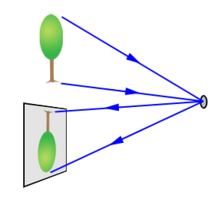
KNOWPIA
WELCOME TO KNOWPIA
Summary
A pinhead mirror can be used to create a camera similar to a pinhole camera. Instead of passing through a tiny aperature, the light to form the image is reflected by a small disc-shaped mirror (with a diameter the same as that of a pinhole; about 0.15 mm - 0.4 mm). One advantage is that a pinhead mirror can be swiveled to scan a scene or project a scene to different locations.[1][2]

Pinhead mirror technology was protected under US patent 4,948,211 - "Method and Apparatus for Optical Imaging Using a Small, Flat Reflecting Surface" until the patent expired in 2009.
Disco balls can be used as pinhead mirrors to project solar images. The math behind them is the same as for a square pinhole. [3]
References edit
- ^ Nilsson, T. H. (1986). "Pinhead mirror: a previously undiscovered imaging device?". Applied Optics. 25 (17). Optica Publishing Group: 2863. doi:10.1364/ao.25.002863.
- ^ Nilsson, Thomy H. (1988). "Pinhead Mirrors: Imaging, Computing and the Nature of Light". Psychology. Pinhole Journal. 4: 2–5.
- ^ Cumming, Robert J.; Pietrow, Alexander G. M.; Pietrow, Livia; Cavallius, Maria; Petit dit de la Roche, Dominique; Pietrow, Casper; Schroetter, Ilane; Skan, Moa (2024). "Why every observatory needs a disco ball". Physics Education. 59 (2). IOP Publishing Ltd: 025012. arXiv:2309.14173. doi:10.1088/1361-6552/ad1fa0.


